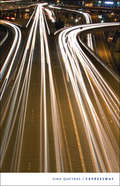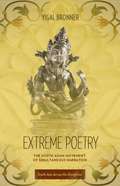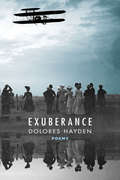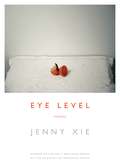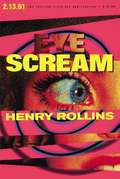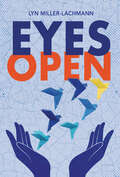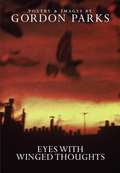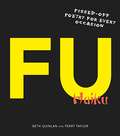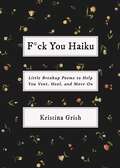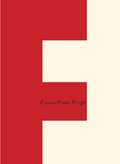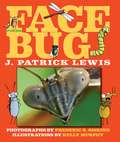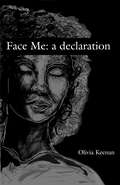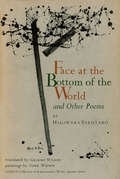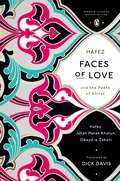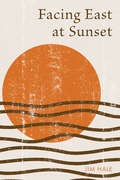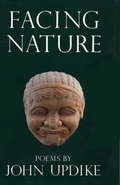- Table View
- List View
Expressway
by Sina QueyrasNominated for the 2009 Governor General's Award for Poetry.This poem resembles urban sprawl. This poem resembles the freedom to charge a fee. The fee occurs in the gaps. It is an event. It is not without precedent. It is a moment in which you pay money. It is a tribute to freedom of choice. Reality is a parking lot in Qatar. Reality is an airstrip in Malawi. Meanwhile the expressway encloses, the expressway round and around the perimeters like wagon trains circling the bonfire, all of them, guns pointed, Busby Berkeley in the night sky. Expressway exposes the paradox of modern mobility: the more roads and connections we build, the more separate we feel. Sina Queyras has written a bravely lyrical critique of our ethical and ecological imprint, a legacy easily blamed on corporations and commerce, but one we've allowed, through our tacit acquiescence, to overwhelm us. Every brush stroke, every bolt, and nut, every form and curve in our networks of oil and rubber, every thought and its material outcome - each decision can make or unmake us.
Extra Hidden Life, among the Days (Wesleyan Poetry Series)
by Brenda HillmanBrenda Hillman begins her new book in a place of mourning and listening that is deeply transformative. By turns plain and transcendent, these poems meditate on trees, bacteria, wasps, buildings, roots, and stars, ending with twinned elegies and poems of praise that open into spaces that are both magical and archetypal for human imagination: forests and seashores. As always, Hillman's vision is entirely original, her forms inventive and playful. At times the language turns feral as the poet feels her way toward other consciousnesses, into planetary time. This is poetry as a discipline of love and service to the world, whose lines shepherd us through grief and into an ethics of active resistance. Hillman's prior books include Practical Water and Seasonal Works with Letters on Fire, which received the Griffin Prize for Poetry. Extra Hidden Life, Among the Days is a visionary and critically important work for our time. A free reader's companion is available online at http://brendahillman.site.wesleyan.edu.
Extracting the Stone of Madness: Poems 1962 - 1972
by Alejandra Pizarnik Yvette SiegertThe first full-length collection in English by one of Latin America's most significant twentieth-century poets. Revered by the likes of Octavio Paz and Roberto Bolano, Alejandra Pizarnik is still a hidden treasure in the U.S. Extracting the Stone of Madness: Poems 1962-1972 comprises all of her middle to late work, as well as a selection of posthumously published verse. Obsessed with themes of solitude, childhood, madness and death, Pizarnik explored the shifting valences of the self and the border between speech and silence. In her own words, she was drawn to "the suffering of Baudelaire, the suicide of Nerval, the premature silence of Rimbaud, the mysterious and fleeting presence of Lautréamont," as well as to the "unparalleled intensity" of Artaud's "physical and moral suffering."
Extreme Poetry: The South Asian Movement of Simultaneous Narration
by Yigal BronnerBeginning in the sixth century C.E. and continuing for more than a thousand years, an extraordinary poetic practice was the trademark of a major literary movement in South Asia. Authors invented a special language to depict both the apparent and hidden sides of disguised or dual characters, and then used it to narrate India's major epics, the Ramayana and the Mahabharata, simultaneously. Originally produced in Sanskrit, these dual narratives eventually worked their way into regional languages, especially Telugu and Tamil, and other artistic media, such as sculpture. Scholars have long dismissed simultaneous narration as a mere curiosity, if not a sign of cultural decline in medieval India. Yet Yigal Bronner's Extreme Poetry effectively negates this position, proving that, far from being a meaningless pastime, this intricate, "bitextual" technique both transcended and reinvented Sanskrit literary expression. The poems of simultaneous narration teased and estranged existing convention and showcased the interrelations between the tradition's foundational texts. By focusing on these achievements and their reverberations through time, Bronner rewrites the history of Sanskrit literature and its aesthetic goals. He also expands on contemporary theories of intertextuality, which have been largely confined to Western texts and practices.
Extreme Poetry: The South Asian Movement of Simultaneous Narration (South Asia Across the Disciplines)
by Michael BronnerBeginning in the sixth century C.E. and continuing for more than a thousand years, an extraordinary poetic practice was the trademark of a major literary movement in South Asia. Authors invented a special language to depict both the apparent and hidden sides of disguised or dual characters, and then used it to narrate India's major epics, the Ramayana and the Mahabharata, simultaneously.Originally produced in Sanskrit, these dual narratives eventually worked their way into regional languages, especially Telugu and Tamil, and other artistic media, such as sculpture. Scholars have long dismissed simultaneous narration as a mere curiosity, if not a sign of cultural decline in medieval India. Yet Yigal Bronner's Extreme Poetry effectively negates this position, proving that, far from being a meaningless pastime, this intricate, "bitextual" technique both transcended and reinvented Sanskrit literary expression.The poems of simultaneous narration teased and estranged existing convention and showcased the interrelations between the tradition's foundational texts. By focusing on these achievements and their reverberations through time, Bronner rewrites the history of Sanskrit literature and its aesthetic goals. He also expands on contemporary theories of intertextuality, which have been largely confined to Western texts and practices.
Exuberance: Poems
by Dolores HaydenTake flight with these dazzling persona poems telling the stories of daredevil pilots in the early days of aviation—from the author of American Yard. Daredevil pilots Lincoln Beachey, Betty Scott, Harriet Quimby, Ruth Law, Ormer Locklear, Bessie Coleman, and Clyde Pangborn fly at carnival altitudes to thrill millions of spectators who have never seen an airplane. In a lyrical sequence of persona poems, the pilots in Exuberance wonder how the experience of moving through the air will transform life on the ground. They learn to name the clouds, size up the winds, mix an Aviation Cocktail, perform a strange field landing, and make an emergency jump.&“Intoxicated with the history of aviation, Dolores Hayden has written a work of historical imagination that is vocally energetic, psychologically acute, and musically sophisticated. . . . The movement between lyrical speech and historical reflection gives us not only a portrait of the early years of the twentieth century, but a book in which technological advance is given a profoundly human voice.&” —Tom Sleigh, poet, dramatist, essayist, author of House of Fact, House of Ruin &“Exuberance is the word for this expansive and exciting collection, and also the word for the vanished earliest days of aviation it evokes, when flying was entertainment and adventure, not everyday transportation. Hayden brings to life a rollicking cast of birdmen and birdwomen, showmen and stunt pilots, producers and profiteers—and their entranced audiences and riders too. . . . Hayden&’s lush and energetic poems give us earthbound readers, used to shuttling from airport to airport, a sense of what that intoxication must have felt like.&” —Katha Pollitt, poet and columnist, author of The Mind-Body Problem
Eye Level: Poems
by Jenny XieFINALIST FOR THE NATIONAL BOOK AWARD FOR POETRYWinner of the Walt Whitman Award of the Academy of American Poets, selected by Juan Felipe HerreraFor years now, I’ve been using the wrong palette.Each year with its itchy blue, as the bruise of solitude reaches its expiration date.Planes and buses, guesthouse to guesthouse.I’ve gotten to where I am by dint of my poor eyesight,my overreactive motion sickness.9 p.m., Hanoi’s Old Quarter: duck porridge and plum wine. Voices outside the door come to a soft boil.—from “Phnom Penh Diptych: Dry Season”Jenny Xie’s award-winning debut, Eye Level, takes us far and near, to Phnom Penh, Corfu, Hanoi, New York, and elsewhere, as we travel closer and closer to the acutely felt solitude that centers this searching, moving collection. Animated by a restless inner questioning, these poems meditate on the forces that moor the self and set it in motion, from immigration to travel to estranging losses and departures. The sensual worlds here—colors, smells, tastes, and changing landscapes—bring to life questions about the self as seer and the self as seen. As Xie writes, “Me? I’m just here in my traveler’s clothes, trying on each passing town for size.” Her taut, elusive poems exult in a life simultaneously crowded and quiet, caught in between things and places, and never quite entirely at home. Xie is a poet of extraordinary perception—both to the tangible world and to “all that is untouchable as far as the eye can reach.”
Eye Scream
by Henry Rollins"Work on Eye Scream started in 1986. I was crossing America constantly andexperiencing the morality shifts, attitudes, and rituals in different partsof the country - the difference in the way people were in the Bible Belt asopposed to New York City, the way blacks and whites interfaced, theintolerance of homosexuality, the morality plays. I started to become awareof how brutal the country is and how much ferocity, cruelty, and oppressionare inherent in the culture and how much of it was in me. I wanted todocument it and create a book that brought the whole thing to a boil and see where it left me off. In the summer of 1995, I finished the book and startedto edit. Re-reading the manuscript over and over, I realized all the things Ihad picked up over a decade of playing Devil's advocate and it was inspiringbecause it clearly defined who my enemies are. As an American, I feel itimpossible not to be infuriated by the way things are and have been. I refuseto be happy about the day-to-day and go along with it. There's too muchspitting in my face and too much spitting in the faces of people who don'tknow any other way of life. This book is brutal, and at times, funny. I knowthat I will probably get a ton of shit for Eye Scream. Enjoy, or betteryet... don't." ---- Henry Rollins
Eyes Like Pigeons
by Roberta ReesCo-winner of the 1992 Gerald Lampert Award. Winner of the 1992 Writers Guild of Alberta Award for Poetry Eyes Like Pigeons, Roberta Rees' long poem, comes back, always, to this: "… Thi' in Vietnamese means poetry." Thi, a Vietnamese refugee, is this book’s associational matrix; playing with the possibilities of her name, Rees writes of Thi, poetry both self-reflexive and self-reflective, and immensely different from that which idealizes women with cliches like the title of this volume. The poetry she finds through Thi is as harsh as it is beautiful; its content as sorrowful as the style is liberating, joyful.
Eyes Open
by Lyn Miller-LachmannPortugal, 1967. Sónia thinks she knows what her future holds. She’ll become a poet, and together she and her artist boyfriend, Zé Miguel, will rise above the government restrictions that shape their lives. The restrictions on what Sónia can do and where she can go without a man’s permission. The restrictions on what music she can enjoy, what books she can read, what questions she can ask. But when Zé Miguel is arrested for anti-government activities and Sónia’s family’s restaurant is shut down, Sónia’s plans are upended. No longer part of the comfortable middle class, she’s forced to leave school and take a low-paying, grueling, dangerous job. She thought she understood the dark sides of her world, but now she sees suffering she never imagined. Without the protection of her boyfriend or her family, can Sónia find a way to fight for justice? This poignant novel in verse follows a teen girl discovering how to resist tyranny and be true to herself.
Eyes with Winged Thoughts: Poems and Photographs
by Gordon ParksIn Eyes with Winged Thoughts, the forty-four photographs and fifty-eight poems, reflecting on his long and extraordinary life, offer a rare glimpse of his thoughts and feelings about everything from romantic love to the Iraq war and the passing of Pope John Paul II. He has done it all. Gordon Parks's life is an astonishing litany of firsts: in the 1940s he was the first African-American photographer to work for the Farm Security Administration and for Vogue and Life magazines; in the 1960s he would become the first African-American director of a major motion picture. A dominating figure in contemporary American culture, he is an artist of uncompromising vision and creativity. In 2002 Parks received the Jackie Robinson Foundation Lifetime Achievement Award and was inducted into the International Photography Hall of Fame, just the latest in a series of honors that began when he received a prestigious Julius Rosenwald Fellowship in 1941 and which now includes an Emmy, a National Medal of the Arts, and over fifty honorary doctorates. Now in his nineties, he could easily rest on his laurels, but the luminous photographs on display in Eyes with Winged Thoughts and the poems -- some meditative and lyrical, some raw with emotion about the war in Iraq and the tragedy of the tsunami -- show that he is still a true American Renaissance man.
Ezjakintasunak
by Gerardo Markuleta GutiérrezJakinaren gainean, ezjakina na-hiago askojakina baino. Bizi bakarra gutxiegi baita buruz bizitzen ikasteko. Dakiguntxoak ez, ez dakigunak adierazten gaitu ondoen.<P> Nabigazioak, jakina, barne kostaldeetan barrena jarraitzen du. Lur umeleko paisaiak dira: gizakiok, berbak eta atxikimenduak endredatuz, ehundu ohi ditugun tratu-molde zaharberrituak.<P> Gero, labur-laburraren esparrua: ekialdera gura gabe, haiku baino areago “kaiku” modukoak. Eta epigrama tankerako zenbait ziri-marra, ondoren.<P> Azkenik –baina ez atzenik–, beste hainbat irrigai: zirrikituez, hauskortasunaz eta artefaktu berbazkoak egiteko grina lagagaitz honetaz.
Ezra Pound
by Betsy ErkkilaNo one better symbolizes the course of modern literature its triumphs and defeats than Pound. From the dreaminess and aestheticism of his early poems, to his Imagist and Vorticist manifestos, to the formally experimental method and mythic engagement with history in The Cantos, Pound marks the path that modern and postmodern poetry would follow. This collection provides a documentary record of the reviews of Ezra Pound's work in contemporary journals and newspapers, an introduction that traces the public outrage and controversy that characterized Pound's reception, and checklists of all known reviews of Pound's work. Most of the major poets and critics of the twentieth-century reviewed Pound's work, including T. S. Eliot, Ford Maddox Ford, William Carlos Williams and Edmund Wilson. Their multiple, perplexed, and sometimes hostile responses to his work provide a rich record of the struggles that marked the emergence of modern and contemporary poetry and poetics.
F U Haiku
by Perry Taylor Beth QuinlanEnough already. The Mary Sunshine act has got to go. The economy sucks, unemployment has reached an all-time high, and the ozone is beyond repair. But when all feels futile, there’s this hilarious compilation of 200-plus rants that give you permission to ditch the rose-colored glasses and have a satisfying laugh at the expense of those who piss you off.From spiteful sex and workplace BS to road rage and famous F Us, you’ll find humorous verbal bitch-slaps to any and all of life’s most annoying and abusive moments.Think of it as therapy, with an edge.
F*ck You Haiku: Little Breakup Poems to Help You Vent, Heal, and Move On
by Kristina GrishGet through any relationship split with this collection of relatable, impassioned, and irreverent breakup haikus.When her marriage came to a sudden and infuriating end, celebrated relationship columnist Kristina Grish found solace in a unique outlet—penning fiery breakup haikus. Now, she shares her cathartic creations in a compilation designed to guide you through the wreckage of your split. In F*ck You Haiku, Kristina has compiled more than 100 breakup haikus— drawing inspiration from her own tumultuous love affairs and universal experiences that strike a chord with us all. These poetic gems serve as a lifeline for anyone grappling with heartbreak, providing a cathartic path to healing. Representing a range of emotions and clever ways to vent about your ex, these haikus are entertaining and enraging, as well as enlightening and empowering. So, if you&’re currently going through a breakup—whether you did the deed or are on the receiving end of it—let this collection of inventive poems help you say &“f*ck you&” to that special someone and eventually &“love you&” to yourself.
F: Poems
by Franz WrightIn these riveting poems, Wright declares, "I've said all that / I had to say. / In writing. / I signed my name. / It's death's move." As he considers his mortality, the poet finds a new elation and clarity on the page, handing over for our examination the flawed yet kneeling-in-gratitude self he has become. F stands both for Franz, the poet-speaker who represents all of us on our baffling lifelong journeys, and for the alphabet, the utility and sometimes brutality of our symbols. (It may be, he jokes grimly, his "grade in life.") From "Entries of the Cell," the long central poem that details the loneliness of the single soul, to short narrative prose poems and traditional lyrics, Wright revels in the compensatory power of language, observing the daytime headlights following a hearse, or the wind, "blessing one by one the unlighted buds of the backbent peach tree's unnoted return." He is at his best in this beautiful and startling collection.ent peach tree's unnoticed return." He is at his best in this beautiful and startling collection. From the Hardcover edition.
Fables of Representation
by Paul HooverFrom the acclaimed author of Winter (Mirror) and Rehearsal in Black, Fables of Representation is a powerful collection of essays on the state of contemporary poetry, free from the stultifying theoretical jargon of recent literary history. With its title essay, "Fables of Representation," one of the most cogent studies ever written of the New York School of poets (a group that includes the influential poet John Ashbery), this book is required reading for anyone who seeks to understand the poetry and culture of the postmodern period. Author Paul Hoover's wide-ranging subjects include African-American interdisciplinary studies; the position of poetry in the electronic age; the notion of doubleness in the work of Harryette Mullen and others; the lyricism of the New York School poets; and the role of reality in American poetry. Hoover also introduces two provocative essays sure to generate attention and discussion: "The Postmodern Era: A Final Exam" and "The New Millennium: Fifty Statements on Literature and Culture."
Face Bug
by J. Patrick Lewis Kelly Murphy Fred SiskindIn this ingenious picture book, Children's Poet Laureate J. Patrick Lewis invites you to visit the Face Bug Museum. There, readers can meet fourteen bugs in Lewis's sly, humorous poems; gaze upon giant close-ups of the creatures' faces in Siskind's photographs; and follow the antics of two beetle friends in Kelly Murphy's artwork. This is a trip to a museum-built by bugs, for bugs-unlike any other. It is also a poetry collection, macro-photography book, and illustrated story-all in one. Includes end notes with photographs of the entire bugs and further information about these creatures.
Face Me: A Declaration
by Olivia KeenanFace Me: a declaration reveals the complexities of a mixed race identity through religion, sex, American history, and colorism. The poems in Face Me reject any white supremacy that dictates Biblical interpretations, historical truths, and beauty standards. This collection of poems follows a journey that begins in uncertainty, but concludes in celebration. Within its pages, declarations are unwaveringly signed and spoken. Black bodies are praised and exalted. Faith is reexamined and reclaimed. And Face Me exists not as a question, but as a command.
Face at the Bottom of the World and Other Poems
by Graeme Wilson Hagiwara Sakutaro York WilsonThe poetry of Hagiwara Sakutaro is still little known in the in the English-speaking world, though this is not altogether surprising when the importance of his work remains inadequately recognized in Japan itself. Nearly all Japanese critiques of post-Meiji poetry acknowledge Hagiwara as one of the best (if not, indeed, the very best) of modern Japanese poets; but almost all critics, having briefly made some such admission, thereafter shy away from him, strangely to devote long paragraphs to other poets patently less talented, sadly more diffuse and far less influential. Why? Perhaps the reason is that Hagiwara, for all his brilliance, seems somehow to switch on darkness, to radiate black luminance. In the beaconry of modern Japanese literature he is an occulting, rather than a flashing, light: but he remains nevertheless a lighthouse of supreme importance.
Face at the Bottom of the World and Other Poems
by Graeme Wilson Hagiwara Sakutaro York WilsonThe poetry of Hagiwara Sakutaro is still little known in the in the English-speaking world, though this is not altogether surprising when the importance of his work remains inadequately recognized in Japan itself. Nearly all Japanese critiques of post-Meiji poetry acknowledge Hagiwara as one of the best (if not, indeed, the very best) of modern Japanese poets; but almost all critics, having briefly made some such admission, thereafter shy away from him, strangely to devote long paragraphs to other poets patently less talented, sadly more diffuse and far less influential. Why? Perhaps the reason is that Hagiwara, for all his brilliance, seems somehow to switch on darkness, to radiate black luminance. In the beaconry of modern Japanese literature he is an occulting, rather than a flashing, light: but he remains nevertheless a lighthouse of supreme importance.
Faces of Love: Hafez and the Poets of Shiraz
by Dick DavisA giant of world literature, an eloquent princess, a dissolute satirist these are the three voices translated from fourteenth-century Persian by Dick Davis in Faces of Love. Together, they represent one of the most remarkable literary flowerings of any era. All three Hafez, Jahan Malek Khatun, and Obayd-e Zakani lived in Shiraz, a provincial capital in south-central Iran, and all drew support from arts-loving rulers at a time better known for invasions and political violence. Love was a frequent subject of their work: spiritual as well as secular, in varieties embracing every aspect of the human heart. They could hardly have been more different. Hafez destined to win fame throughout the world wrote lyrical poetry that was subtle, elusive, and rich in ambiguity. Jahan largely forgotten until recent decades was a privileged princess who could evoke passion, longing and heartbreak with uncanny power. (As Davis says: "To have this extraordinary poet's fascinating and often very beautiful poems emerge from six hundred years of virtual oblivion seems almost miraculous". ) Obayd a satirist and truth-teller celebrated every pleasure of the flesh in language of astonishing and occasionally obscene honesty. In his introduction, Davis himself a gifted poet as well as an acclaimed translator and scholar of Persian literature describes the turbulent world of the three poets and recounts what is known of their lives. His scene-setting includes explanations of poetic conventions of the day: the rules of rhyming and meter, the stylised relationship between author and subject, and the way language sometimes hovers between male and female or between sacred and secular meanings. Detailed explanatory notes follow the poems, along with some personal reflections on the challenge of trying to catch the poetic genius of a culture distant in space and time. Dick Davis does it brilliantly: Faces of Love is a bridge that carries us to another age.
Facing East at Sunset
by Jim HaleDo you want to return to a time in your life when things were wonderful, filled with people you loved, with dreams that you had, when the world was simpler and the future glistened? And do you wonder what happened, where did those years go? The answer, my friend (no, not with Bob Dylan), is with you inside your head, all the good and some of the bad. The answer is writing it down – it’s still there – in poetry. Reading others, writing your own. Think back – it’s still there – look back, look forward… poetry. Do you recall those violet-infested walls of that old English church; that girl you saw and never forgot in a tavern once visited; that old town you first taught in and that noisily funny dunny-cart man; the fear of being trapped in a crashed car with petrol dripping; resting in love with a beautiful partner; dangling a line in a beautiful river with beautiful sons? It’s all there, deep down, relived and reloved, in poetry.
Facing Nature
by John UpdikeJohn Updike's fifth collection of poetry faces nature on a number of levels. An opening section of sonnets touches upon death, aging, and, in a sequence of describing a week in Spain, insomnia and dread. The poems that follow consider nature in the form of seasons, of planting trees and being buried, of shadow and rain, of pain and accumulation, and of such human diversions as art and travel. The last poem here, and the longest in the book, undertakes a walking tour of each of Jupiter's four major moons, a scientific excursion that leads into the extravagant precisions of the "Seven Odes to Seven Natural Processes," a lyrical yet literal-minded celebration of some of the earthly forces that uphold and surround us. Finally, a dozen examples of light verse toy with such natural phenomena as presbyopia, the energy crunch, food, and sex. Like the best of the metaphysical poets, Mr. Updike embraces the world in all its forms and creates conceits out of the casual as well as the moments.
